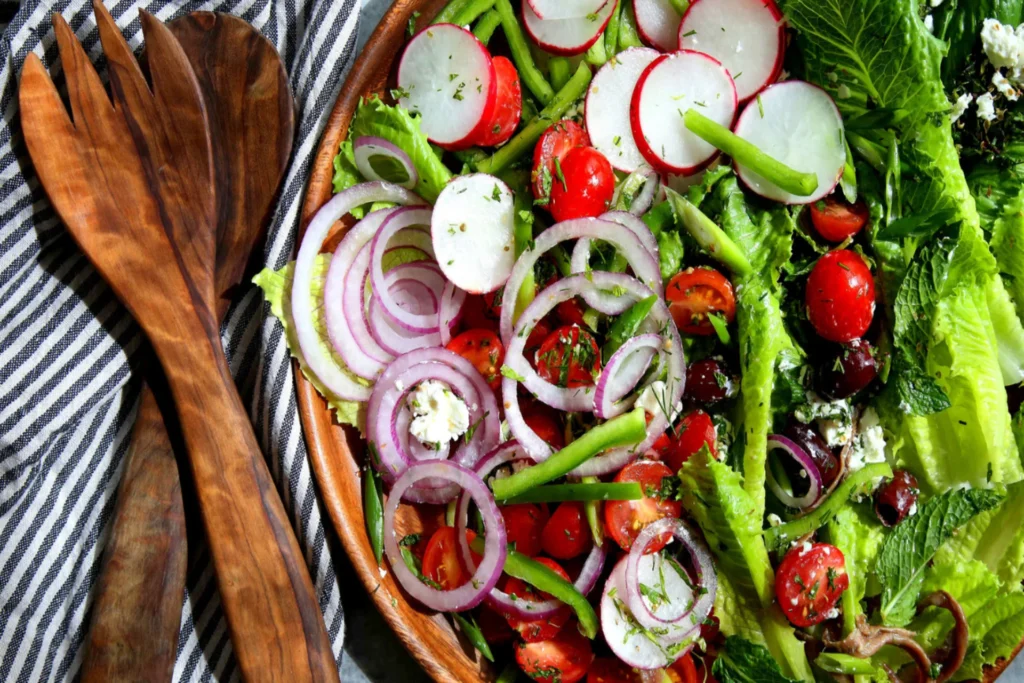Something is refreshing in a well-prepared Greek salad that delivers the Mediterranean directly to your table. It’s simple, yet flavorful, with crisp vegetables, tangy feta, and highly aromatic olive oil. Greek salad stands out beyond being a side order; it’s a burst of sunshine that can easily stand alone as a meal. In this post, we’ll take you through an easy Greek salad recipe while exploring the health benefits of its ingredients. Some frequently asked questions about a Greek salad and some tips for an SEO-optimized blog post are also revealed in this article.

Table of Contents
Why Greek Salad?
Horiatiki is a Grek salad, a traditional food product that took the whole world by storm because it’s so easy, fresh, and full of color and healthy treats. It combines juicy tomatoes, crunchy cucumbers, sharp onions, olives, and the creaminess of feta cheese, all drenched with olive oil and a few sprigs of oregano on top. This salad is great for hot days when you feel like eating something light but still healthy.

Ingredients:
4 ripe tomatoes –cut into wedges
1 large cucumber – peeled and sliced into thick rounds
1 red onion – thinly sliced
1 green bell pepper – sliced into rings
1/2 cup Kalamata olives –pitted
200g block of feta cheese – cut into large cubes or crumbled
1/4 cup extra virgin olive oil
1 tablespoon red wine vinegar
1 teaspoon dried oregano
Salt and pepper to taste
Instructions
Prepare the vegetables: Rinse and chop all the vegetables. Chop the cucumbers into thick rounds and the tomatoes into wedges. Slice the onions thinly so that their bitterness will be balanced out by the other ingredients in the salad.
Assemble the salad: Mix the chopped tomatoes, cucumbers, and green bell pepper in a large salad bowl. Add the thinly sliced onions and Kalamata olives.
Add the feta: Traditionally, a Greek salad will top with a big block of feta cheese. You may also wish to crumble the feta over the salad for a more even distribution of the flavor.
Assemble the salad: Sprinkle the extra virgin olive oil and red wine vinegar over the salad. Add oregano sprinkled on top; season with salt and pepper to taste, but watch that salt since the feta and olives are salty enough.
Toss and serve: Toss the salad gently, so that all the flavors combine. Serve immediately, preferably with a side of crusty bread to dip into the lovely dressing.

Why This Greek Salad is Healthy and Nutritious
Tomatoes: Tomatoes are full of antioxidants, lycopene particularly, and how it reduces inflammation and more importantly supports heart health.
Cucumbers: Low in calories and high in water content, cucumbers hydrate while assisting with digestion.
Red Onions: Antioxidant and anti-inflammatory compounds make onions a good supporter of heart health.
Kalamata Olives: With sturdy flavor and richer, darker brine, Kalamatas score highly in healthy monounsaturated fats that contribute to heart health.
Feta Cheese-Feta is made from sheep’s or goat’s milk so is lower in fat and calories compared to cheese made from cow’s milk. It also contains a wealth of calcium and protein.
Extra virgin Olive Oil is one of the healthiest fats: a healthy carry-all of antioxidants and anti-inflammatory compounds. A staple of the Mediterranean diet, it is most frequently associated with improved heart health and longevity.

1. Can I make Greek salad in advance?
Yes, you can prepare Greek salad in advance, but it’s best to keep the dressing separate until you’re ready to serve. This prevents the vegetables from becoming soggy. Simply combine the vegetables and store them in the refrigerator, then add the dressing just before serving.
2. Can I customize the ingredients?
Absolutely! While the traditional Greek salad includes tomatoes, cucumbers, onions, olives, and feta, you can add or substitute ingredients based on your preference. Some people enjoy adding lettuce, avocado, or even grilled chicken for added protein.
3. Is Greek salad keto-friendly?
Yes! Greek salad is low in carbs, making it an excellent option for those following a keto diet. Just make sure the olives and cheese you use don’t contain any added sugars or starches.
4. How long does Greek salad last in the fridge?
If stored properly in an airtight container, Greek salad will last for up to 2 days in the fridge. However, the fresher the salad, the better the flavor, so it’s recommended to enjoy it within 24 hours.
5. What can I serve with Greek salad?
Greek salad pairs beautifully with a variety of dishes. Serve it alongside grilled meats like chicken souvlaki, lamb, or seafood. It also works as a light main course with a side of pita bread or rice.
6. Can I make this salad vegan?
Yes, to make a vegan version of Greek salad, simply omit the feta cheese or replace it with a plant-based alternative. Many vegan cheese brands offer feta-style cheese made from coconut oil or tofu that replicates the flavor and texture of traditional feta.
7. What is the best olive oil to use for Greek salad?
Extra virgin olive oil is ideal for Greek salad as it’s unrefined and retains more of the natural flavors and health benefits. Look for high-quality, cold-pressed olive oil, preferably from Greece, to keep the authentic taste of the salad.
